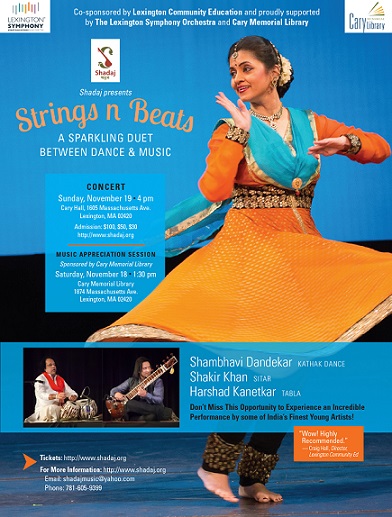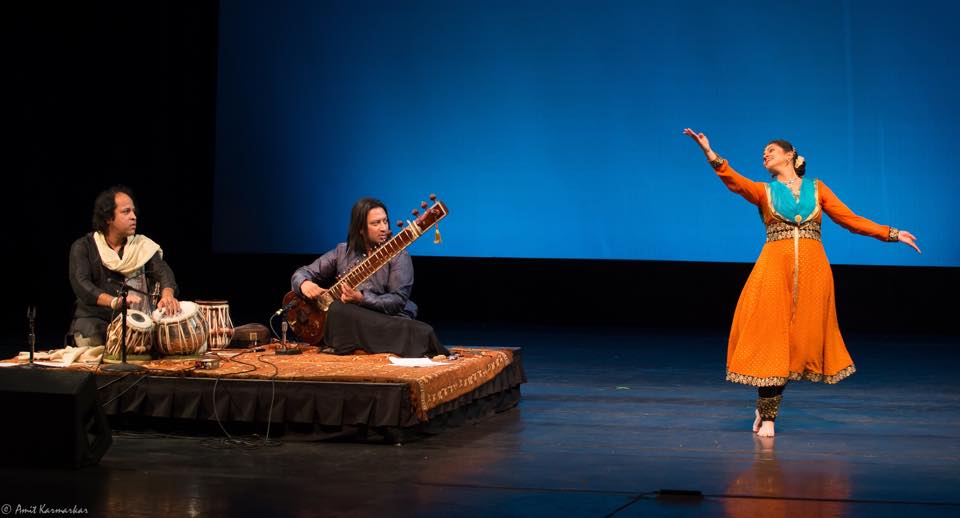Contribute
| Kathak, Sitar And Tabla - A Visual And Auditory Feast |
Aishwarya Karnik and Shashank A. Nene
10/12/2017
Kathak, Sitar and Tabla - a Visual and Auditory Feast Kathak, the Indian classical dance, in its very essence is about story telling. In fact, "Kathak" comes from the word "Katha" meaning "story". Through graceful gestures, intricate footwork and evocative expressions, the dancer weaves a lively tapestry of stories set to rhythm. This composite art form can trace its ancient origins to wandering kathakars or story-tellers in North India and is said to be a tradition which originated around 400 BCE. An established genre of Indian classical dance today, Kathak has evolved over the years, assimilating several influences including those of Hindu and Mughal traditions. Many of the colorful and exotic dances seen today in Indian "Bollywood" films have strong roots in Kathak traditions. Shambhavi Dandekar intuitively understands the enormity of that tradition and its nuances having been born into it, so to speak. The daughter of renowned Kathak danseuse Maneesha Sathe, Shambhavi’s earliest memories are infused with the musical cadence of ghungroos (bells) on dancing feet. It is hardly surprising then that Shambhavi gave her first dance performance at the age of four. Since that early start, this danseuse has come a long way, from becoming her mother’s disciple, performing alongside her, to striking out on her own. She credits her success to the training imparted by her guru and mother, Maneesha Sathe, a believer in disciplined and rigorous riyaaz or practice. Shambhavi has also trained extensively in rhythm and aesthetics with Tabla maestro Pandit Suresh Talwalkar, and in Hindustani vocal music with guru Mangala Vaidya. The Sitar was originally popularized in West by Pandit Ravi Shankar and from Woodstock to prestigious concert halls, its soulful music and subtle nuances have entranced western audiences. Shakir Khan, disciple and son of renowned sitar Ustad Shahid Parvez, is a leading Sitar virtuoso of his generation. His instinctively spontaneous sense of creativity exceeds the tunefulness of his melodies. The rigidity of his rhythmic control and the exquisite balance and proportion that flows forth so naturally in his music brings freshness and life to each performance. Accompanying them both, is Harshad Kanetkar. He is a percussionist who learnt his art form from the Tabla maestro, Pandit Suresh Talwalkar and has been a frequent performer in the United States. He lends beat and rhythm to Shambhavi's graceful steps and Shakir's enchanting notes and the three create an exquisite auditory and visual spectacle. Aficionados of the arts and all that is exotic, can now see the beautiful traditions of both Kathak and the Sitar come alive together with the Tabla in an expressive interplay that will leave the audience spellbound. Strings N Beats is a unique dialogue between dance and music to be held on Sunday, from 4:00 pm to 6:00 pm, on November 19, 2017 at Cary Hall in Lexington, MA. Organized by Shadaj (a non-profit organization founded by volunteers from Lexington and the greater Boston area), Lexington Community Education, the Indian Association of Lexington and the Cary Memorial Library, this musical treat is sure to add sparkle to the fall arts calendar. On the day before this performance (on November 18, between 1.30-3 pm), music lovers can also enjoy an up-close-and-personal encounter with the artistes at a special music appreciation session, at the Cary Memorial Library, free of charge. The artistes will discuss and demonstrate nuances of their respective art forms and answer questions from the audience. Tickets for the performance on November 19 are available at http://www.shadaj.org and lokvani.com.
You may also access this article through our web-site http://www.lokvani.com/

